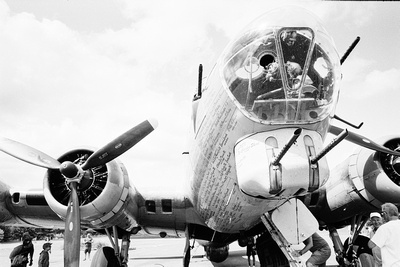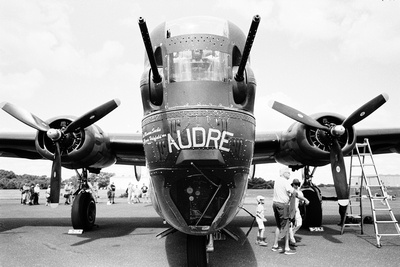Leica IIIc and Screw-Mount LTM Lenses
THE STORY
Already owning Leica M film cameras, it might come to a surprise why I would bother with an earlier Leica camera made in the late 1940s after WWII. By chance I saw that an auction house two hours away from my home listed this Leica IIIc camera with original Leica 50/2 Summitar lens and two additional chrome M-mount lenses as part of an upcoming auction in which I was interested in also for other items (microscopy-related gear and books). The camera's serial# revealed that it was not a collector item but a standard series instead. So I decided to take a day off from work and head down to PA early in the morning to have a closer look at the items I was already interested in by seeing the posted photos online. The camera obviously hasn't been used for a long time - the lens was quite dusty on the front lens but otherwise scratch-free, and the aperture ring was a bit sticky but worked fine. The camera body had a little crack in the skin, both the rangefinder and the viewfinder windows were very hazy inside and nearly unusable. But the shutter seemed fine and also most shutter times still worked well judging by the difference in time for the shutter to close. Only a few slower shutter times didn't work. I quickly realized that the camera had no major drawback, and mostly might just needed CLA (cleaning-lubrication-adjustment). Interestingly, there was an original Leica manual underneath the camera in the box - but for a Leica M3 camera which I already own. The M3 camera itself was not part of the auction - I never found out what happened with it but suspect that someone kept it before it could become part of this auction. The additional two Leica lenses in chrome versions - a collapsible Leica 90/4.0 Elmar and a Leica 135/4.5 Hektor lens came both in M-mount and were obviously part of the M3 camera set but added in error to the Leica IIIc screw-mount camera. Both M-mount lenses were in very good shape and made in the late 50s, just a bit dusty on the outside. At this point I set in my mind the highest possible bid for the package and hoped nobody else would be as interested in it as I was at this point. More people entered the auction hall afterwards, and a bunch of them looked at the camera but either had no idea how to operate it or were scared by the dusty/old appearance.
After a few hours in the auction - which was also streamed for online bidding - finally this Leica camera gear had its turn. It started with $10 and went quickly up to $100 - then it was just me competing with another bidder in the room and someone online. The price continued to increase, at $150 the other bidder inside the room left, and it was just me and the online bidder. My comfortable limit in my mind was set to $300, so I came closer and closer to this when the price went above $200. Lucky me the online bidder stopped adding bids after the $250 mark was reached - I was the only one remaining and got all for this price (plus auction fee and tax of course). It was a very good deal, and I saved enough money here to send the IIIc with Summitar lens in for CLA for another $200. When I received the camera with lens back from service, it looked amazing - new skin, clear rangefinder and viewfinder windows, shutter times fully operational, all mechanical parts moving smoothly. The lens was cleaned inside out and then reassembled - it looks like new. The other two chrome M-mount lenses I received work flawlessly after a bit of cleaning by myself on my M-mount cameras - especially on my Leica M3 with its 0.91x viewfinder. I found that currently each lens is sold online between $300-$400. But for now they are keepers for me, too.
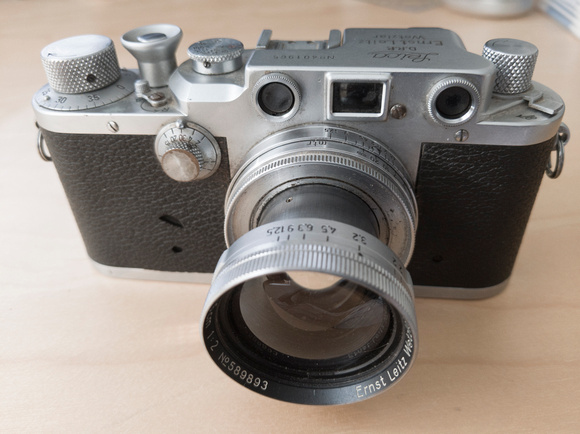

The look of the Leica IIIc with Summitar 50/2 lens after the auction. Some cracked skin on the lower left, a bit dusty, and hazy windows, and not fully working slow shutter speed dial were the only obvious camera issues. The lens was scratch-free for its old age!
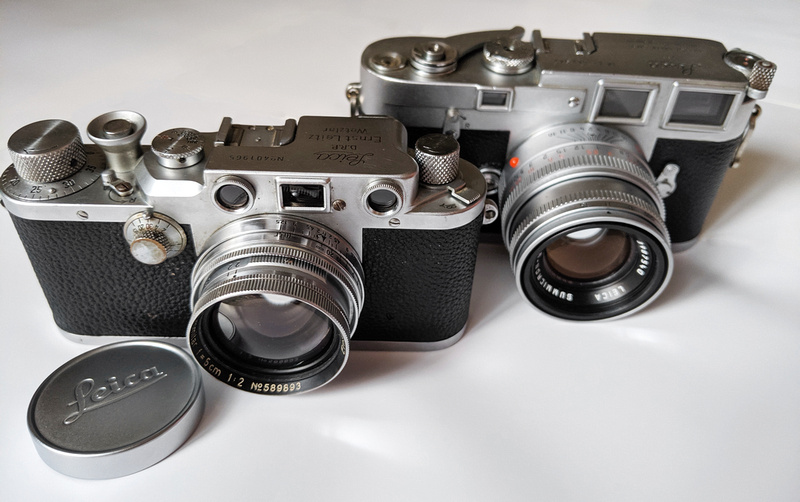

The shutter curtain of my Leica M3 (in the back of the photo) broke just at the time when I got the IIIc - both made a trip for service and repair. That's how the cameras - Leica IIIc and M3 - looked after I got them back. Also the Summitar lens was cleaned and lubricated. All looks like new! The size comparison is misleading in the photo: the IIIc is much smaller in size than the M3 in the back!
LEICA IIIc REVIEW
The IIIc camera is clearly its own class of so-called Leica Barnack cameras. They are fully mechanic cameras without need of battery and have no light meter. Lots of levers and buttons to operate the camera correctly - not the right tool to make fast adjustments during some shooting. But the built-style and vintage look - simply superb. The III-series is much smaller in size than the later produced first Leica M-cameras (M3 and M2 for example) and built as a rigid steel/brass body. The original L39/LTM series lenses were collapsible which additionally kept the rangefinder lens size very small to carry. I wonder which kind of modern camera would last over 70 years and could still work with some lubrication and cleaning like on its first day. Even taking electronic materials out of the equation, a camera isn't built like this since many decades.
Leica made sure that all cameras which followed the original III-versions could still use the original screw-mount lenses with thin adapter on the newer bayonet M-mount. On the other hand, it causes a major hurdle when trying to go the other way like I did now - I started with M-mount cameras and lenses and now suddenly owned a screw-mount camera. I figured quickly that M-mount lenses unfortunately do not fit on the older LTM/L39 cameras: the flange distance of screw-mount LTM cameras is longer than the ones of newer M-mount cameras (which seems a contradiction on the first look since the IIIc camera is smaller in size compared to the M3 for example). This means that the adapter to mount a LTM lens onto a M-mount camera compensates for the shorter flange distance of the M-camera and pushes the LTM lens a bit further out. But you can't use a M-lens made for a shorter flange distance on a camera which requires a longer one! So all my nice an d excellent M-mount lenses don't work on the IIIc. Even this is a bummer, it has one benefit: The IIIc forces me to use LTM lenses which might not be as optimized for later quality requirements - a real vintage- and character-style shooting experience!
I downloaded a user manual for the IIIc and watched some You Tube videos online to know how to operate the camera correctly. It was a short learning curve for me since I am already used to film gear and newer Leica cameras. One thing which was new to me was the bit cumbersome film loading with the IIIc: First, the film strip needs to be cut in a unique way to enable the camera to reel it. I found best is to make a cardboard screen which can be held onto the film strip to cut 10 cm in length off the top. Very important is to have exactly two sprocket holes open before the strip ends at the film cartridge outlet. I found this not well documented in the Leica manual I downloaded but much better described in some "How to Insert Film Into the Leica IIIc" videos. Next the film spool has to be taken out of the inside of the camera - it is a good idea to check that it is included when buying a used Barnack camera! The end of the film strip is squeezed into the spool - make sure the spool is in the correct way which means that it will appear awkward since Leica decided to have the film sitting in the camera with more tension to flatten it against the original turn how the film is rolled inside the film cartridge. The most tricky step comes next to insert cartridge and spool correctly placed in the camera - later M-camera models have a self-adjusting mechanism which moves the advanced film in the right position. The IIIc does not have this - to check that the film is placed correctly, fire one or two exposures, remove the lens on the camera and then use the "B" shutter position to see inside while pressing on the shutter release. The shutter curtain will remain open and makes the film plane visible while the shutter release is pressed. If you see any kind of sprocket holes on top or bottom, you need to reverse the film, put it back in the camera and check again until all sprocket holes of the film are covered. This is very cumbersome and makes changing a film in the field nearly impossible to do quickly. It is IMO the biggest drawback of the camera. But like with anything, the more often you practice the easier it will get.
If you are used to a modern digital, SLR, or modern rangefinder camera, you will be confused to see two little windows next to each other on the upper left on the back of the IIIc camera. When this camera was made, Leica still had the rangefinder focusing path and the viewfinder separate from each other - therefore two windows for each. With the left window you focus on a magnified central area in your view by bringing two frames on top of each other like any other rangefinder focus works. I found it remarkable that this older rangefinder style uses a bit of yellowish circular spot in the middle of the focus area in the rangefinder path which actually helps to bring lines together to achieve focus. I am not sure if this is standard in all this kind of cameras, or if this is a bit of a fluke just in my copy - in any way it is not obstructing and actually helps. The right window is the viewfinder adjusted for 50 mm focal length. After shooting a few films with the camera and the attached 50/2 Summitar lens, I can tell that the viewfinder window is just a rough estimate of the view you will be getting in the final image. The viewfinder gives you a bit wider field of view that what you actually get with a 50 mm lens. I believe that this is the reason why some use an external 50 mm viewfinder on the camera's hotshoe to allow better framing. But since this is a vintage camera fun for me to shoot with, I simply deduct a bit on each side of the viewfinder's frame to be fairly accurate on the taken image.
There are no other "frame lines" with this kind of camera - for any other focal length than 50 mm, you rely on an external viewfinder. When you consider getting one, best is to ask yourself first which kind of focal length you will be shooting with this camera. You can potentially get a Leitz VIOOH finder which has multiple viewfinders for 35-135 mm range in a revolver-like device setup. It is very bulky and likely attracts attention - I rather prefer a smaller more inconspicuous one. Since I am shooting more wide than tele, I continue using my Cosina-Voigtlander 21/25 external viewfinder also on my IIIc. When I get my 35 mm screw-mount lens, I will be using my cheap little Braun Paxette 38 mm external viewfinder which is sufficient (35 mm LTM lens review will be part of a future blog).
Talking of wider than 50 mm screw-mount LTM lenses - I was shocked to see online prices of old Leitz lenses. I suspect collector demand drove prices up especially for 35 mm Leitz LTM lenses. But also older Nikkor and Canon LTM lenses go for (too) much IMO. After a while of digging and searching, I found a more reasonable option as used copy online for a Voigtlander 25/4.0 Snapshot-Skopar LTM lens which I intend to use with adapters also on my M-cameras and my digital Sony A7R. I didn't know when I bought it, but the 25/4.0 has no rangefinder coupling. The lens is purposely built not to use the rangefinder focusing but simply to estimate the distance. Hyperfocal distance setting is very good with this lens which leads to excellent sharpness at f/8 for nearly all shots I took with this lens. It is the smallest wide angle lens I own - it fits in any pocket! If you shoot wider, I highly recommend this lens (and external CV 21/25 viewfinder) for the IIIc-type camera.
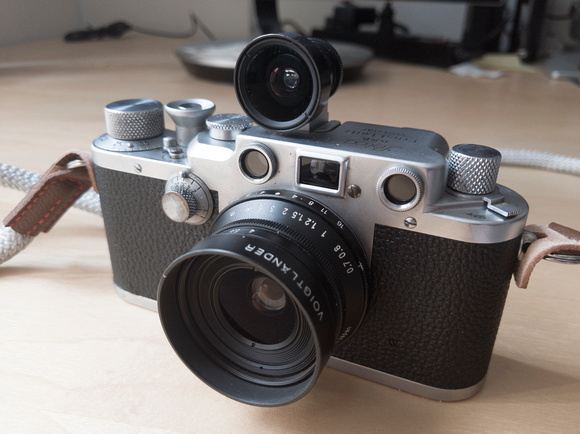

Leica IIIc with attached Cosina-Voigtlander 25/4.0 Snapshot-Skopar LTM lens and Cosina-Voigtlander 21/25 external viewfinder. The lens is super small and light for a 25 mm wide angle lens with f/4.0. You can tell from the distance scale that the focus ring doesn't need to be moved much between 0.7 meters and infinity.
The collapsible Leica 50/2 Summitar lens was produced in the 30s/40s in many different versions and iterations, and only collectors and experts for this kind of lens gear know all the differences between them. I know that mine was manufactured in Wetzlar/Germany in 1942 judging by its serial# - during WWII! It might have an interesting history to tell how it made it to the US and how many owners the camera and/or lens had before I got my hands on it. At the time not many were able to afford such camera gear in Germany. Judging by the condition of camera and lens, they were likely not traded and used too often. To see the Summitar lens unscratched with > 70 years after its manufacturing date is very unique. After having it serviced, I was told that there is some minor lens delamination starting on the side of one of the lens elements, but it does not affect image quality. Delamination is quite normal for a lens of this age. At the time when this lens was produced, Leitz also did not yet apply coatings on this lens.
The lens blocks a little bit one of the viewfinder corners which I didn't find an issue but worthwhile mentioning since this lens does not block the viewfinder attached to M-mount camera bodies. The lens delivers very sharp images in the center but even at around f/8 the corners tend to be slightly unsharp which is the character of the Summitar lens. My lens has some unusual f-stop numbers engraved, so f/5.6 or f/8 have to be sort of guessed. There are no click-stops on the f-stop dial, the 10-bladed diaphragm is opening and closing smoothly depending on the reel position. Supposedly this lens provides beautiful sunstars, but I haven't explored this option yet.
In the field, I found the IIIc is easier to operate than expected. Winding to the next frame takes a bit longer with the turning knob compared to M-cameras with single or double-stroke lever. But you likely won't use this kind of camera for action shots in the first place - the IIIc slows you down just enough to think about a good composition but is still fast enough to be used well for street photography. The camera feels extremely pleasant in my hand to hold it. I bought a cotton leather neck strap for the camera, and it didn't bother me at all carrying the IIIc for hours. The rangefinder focusing worked extremely well in sunlit and cloudy conditions as well. To my surprise, the shiny protruded lens element of the Summitar lens did fortunately not gain attraction either. It is still all very small and compact. The design of this camera is nothing but beautiful and everything seems just right in the positioning of buttons and levers. After reading online reviews and watching videos about the III-series, I was ready in my mind for some slow-downs and drawbacks to actually use this camera but the opposite happened: it quickly became a favorite tool to shoot 35 mm film.
The only hassle brings me back to the film loading with the IIIc. When using M-cameras and the IIIc in parallel, you have to use best judgment upfront which kind of films you might use during a field trip with the IIIc. Cutting the film lever into the desired length and form seems quite an inconvenience when being outdoors, so it better has to be done earlier at home. You could still use the film with prepared long film lever when changing plans and intending to use this film for example with a M-mount camera instead - a simple cut with a scissor will do but some exposures will then be lost compared to a regular 35 mm film.
One more advice in regard to the tripod mount: similar to older M-mount cameras, the IIIc uses a 3/8" screw-mount tripod mount. Most tripod plates these days use a 1/4" screw - you need an adapter to fit it into the mount on the camera's base plate. But careful - regular 3/8" to 1/4" adapter screws protrude quite a bit on the IIIc base plate (they work perfectly fine for the M3 for example!). You have to file off a bit from a regular screw adapter to make it fit, or you order a so-called screw adapter for Rolleiflex and Rolleicord cameras which seem to have the same length.
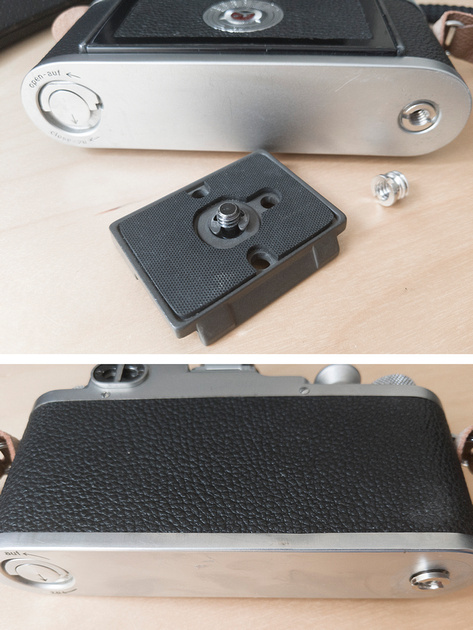

Surprise, surprise....the generic 3/8" to 1/4" screw-mount for 1/4" based tripod plates fits well on the Leica M3 base plate (top) but protrudes quite a few mm on the Leica IIIc with thinner base plate (bottom).
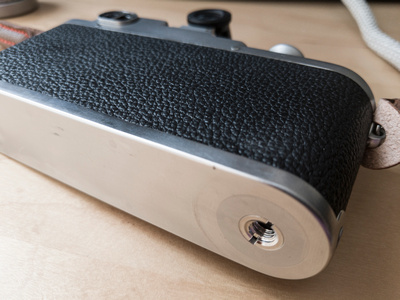

Getting the fitting Rolleiflex/Rolleicord screw adapter for 1/4" tripod plate mounts works!
USEFUL ACCESSORIES FOR THE LEICA IIIc
There are a few quite affordable accessories which come in handy with this camera body. I tend to stay here with third-party suppliers since they are much cheaper than the original Leitz/Leica items (and do the same in the end):
(a) LTM/M adapter (approx. $10): very useful to mount LTM lenses also on other M-mount cameras. I can even mount the LTM/M adapter directly onto my M/E-mount adapter to use screw-mount rangefinder lenses on my Sony A7R camera.
(b) Cable release. To use this, I have to unscrew the shutter release button to gain access to a screw thread surrounding the release pitch. The cable release can be fitted onto this screw mount. Less well known but works well also as cheapest option is getting a Nikon AR-2 style cable release. They go online for approx. $20 or sometimes even less.
(c) Mentioned earlier in my review is the wide open field of non Leica-based screw mount rangefinder lenses for decent prices (approx. $50-150 for non collector items also dependent on the lens focal length). Russian FED, Industar, or Jupiter lenses can be used with Leica screw-mount cameras. Between Russian and Leica screw-mount lenses is a minor difference in the layout of the helicoid thread pitch, but I doubt that it makes a visible impact on film. These lenses still deliver a quite high image quality on digital mirrorless cameras and certainly do on film. Don't expect perfectionism compared to modern lenses (you wouldn't use the IIIc in the first place if this was the case), but they have character in their little faults. There is a huge range of very affordable Russian 50 mm lenses (Jupiter-8 for example). A bit more expensive but also with character are for example screw-mount lenses from Canon and Nikon (> $250).
Some recently taken photos with the Leica Summitar 50/2 LTM lens and the Leica IIIc:


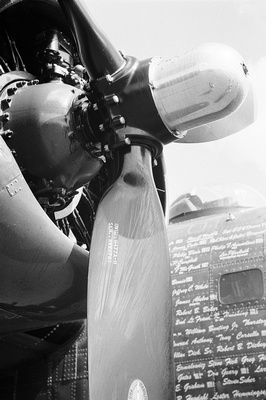

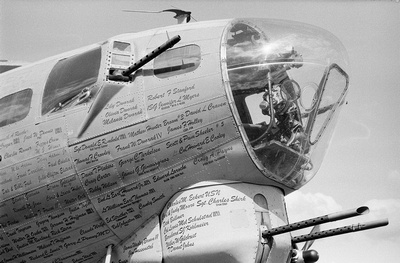

Some photos taken with the Cosina-Voigtlander 25/4.0 LTM lens and the Leica IIIc:
